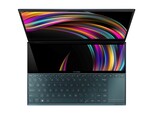Asus ZenBook Duo UX481FL
Ausstattung / Datenblatt

Primary Camera: 0.9 MPix
Preisvergleich
Durchschnitt von 6 Bewertungen (aus 11 Tests)
Testberichte für das Asus ZenBook Duo UX481FL
Asus versucht zu beweisen, dass es immer noch Raum für Innovationen gibt, die über den Trend von jährlich dünneren Laptops hinausgehen. Im besten Fall ist das ScreenPad-Plus-Display praktisch und geradezu unersetzlich, dafür muss man jedoch auch einige ergonomische Kompromisse hinnehmen.
Quelle: Ricks Tech
 Archive.org version
Archive.org versionEinzeltest, online verfügbar, Mittel, Datum: 01.08.2022
Quelle: Ricks Tech
 Archive.org version
Archive.org versionSupport, online verfügbar, Sehr Lang, Datum: 20.07.2022
Quelle: Ricks Tech
 Archive.org version
Archive.org versionSupport, online verfügbar, Sehr Lang, Datum: 28.06.2022
Quelle: It Pro
 EN→DE Archive.org version
EN→DE Archive.org versionAsus has pushed boundaries with the UX481, and there are areas where this machine succeeds. The primary screen offers good quality for sRGB work, and the lower panel is useful for secondary apps. The Asus has smart looks, solid performance and superb battery life. In key areas, though, the daring design means uncomfortable compromise. The cramped keyboard and trackpad can’t compare to Dell and Apple’s offerings, and the Asus is thicker and heavier than rivals. If you’re going to use the secondary screen, then you may be able to accept these issues. If it’s not going to be integral to your work, though, conventional laptops remain better.
Einzeltest, online verfügbar, Lang, Datum: 13.06.2020
Bewertung: Gesamt: 60%
Quelle: Engadget
 EN→DE Archive.org version
EN→DE Archive.org versionThe ZenBook Duo is a solid attempt at delivering a dual-screen ultraportable. Using both screens is intuitive, and it can be genuinely practical for multitasking. But ASUS had to make compromises to fit those screens, especially when it comes to the keyboard and trackpad. It’s also heavier and thicker than any other ultraportable.
Einzeltest, online verfügbar, Lang, Datum: 11.06.2020
Bewertung: Gesamt: 81%
Quelle: Engadget
 Archive.org version
Archive.org versionIf you're considering the ZenBook Duo, the real question you need to ask yourself is how much do you really need two screens on a $1,499 ultraportable. ASUS did a decent job of fitting in a second display, but it leads to plenty of compromises.
Einzeltest, online verfügbar, Mittel, Datum: 10.06.2020
Quelle: The Verge
 EN→DE Archive.org version
EN→DE Archive.org versionBut if you’re looking specifically for a two-screen device, this one works. It’s more than a party trick; it’s useful and there are cool things you can do. But I think the form factor is better suited to a workstation (like the ZenBook Pro Duo) which is likely to spend most of its life at a desk with peripherals plugged in. I’m not sure if there’s a way to make a Duo that’s also good at being a portable laptop. If there is, Asus hasn’t quite found it.
Einzeltest, online verfügbar, Sehr Lang, Datum: 09.06.2020
Bewertung: Gesamt: 70%
Quelle: Trusted Reviews
 EN→DE Archive.org version
EN→DE Archive.org versionIf you’re going to benefit from the second screen – whether it’s in creative applications or just by bumping useful tools downwards – then the Duo is worth considering. If not, then more traditional notebooks remain better due to the number of design compromises Asus has had to make.
Einzeltest, online verfügbar, Lang, Datum: 18.05.2020
Bewertung: Gesamt: 70%
Quelle: Laptop Mag
 EN→DE Archive.org version
EN→DE Archive.org versionThe ZenBook Duo isn't as powerful as the ZenBook Pro Duo, but it delivers nearly all the same functionality at a significantly lower price. As a result, the Duo is a better option for all but the most demanding power users. First, you need to decide if the ZenBook Duo is right for you, or if a more traditional laptop, like the Samsung Galaxy Flex 15 or Lenovo Yoga C940 would be a better fit.
Einzeltest, online verfügbar, Sehr Lang, Datum: 16.05.2020
Bewertung: Gesamt: 80%
Quelle: Mega Obzor
 RU→DE Archive.org version
RU→DE Archive.org versionPositive: Impressive dual display; powerful processor; elegant design; comfortable keyboard; light weight; nice performance. Negative: No USB-C; overheats while using.
Einzeltest, online verfügbar, Sehr Lang, Datum: 04.05.2020
Quelle: Zing
 VN→DE Archive.org version
VN→DE Archive.org versionPositive: Impressive dual display; powerful hardware; premium design; solid workmanship.
Einzeltest, online verfügbar, Lang, Datum: 16.09.2020
Kommentar
NVIDIA GeForce MX250: Umbenannte MX150 und damit weitherhin Pascal GP108 basierende Notebook-Grafikkarte und mobile Version der GT 1030. Bietet 384 Shader und meist 2 GB GDDR5 Grafikspeicher. Die Taktraten sind ev. etwas oberhalb der MX150 angesiedelt. Weiterhin als normale (25 Watt) und langsamere Stromsparvariante (10 Watt) erhältlich.
Diese Klasse ist noch durchaus fähig neueste Spiele flüssig darzustellen, nur nicht mehr mit allen Details und in hohen Auflösungen. Besonders anspruchsvolle Spiele laufen nur in minimalen Detailstufen, wodurch die grafische Qualität oft deutlich leidet. Diese Klasse ist nur noch für Gelegenheitsspieler empfehlenswert. Der Stromverbrauch von modernen Grafikkarten in dieser Klasse ist dafür geringer und erlaubt auch bessere Akkulaufzeiten.
» Weitere Informationen gibt es in unserem Notebook-Grafikkartenvergleich und der Benchmarkliste.
i7-10510U: Auf der Comet Lake-Architektur basierender ULV-SoC (System-on-a-Chip) für schlanke Notebooks und Ultrabooks. Integriert unter anderem vier CPU-Kerne mit 1,8 - 4,9 GHz (4,3 GHz für alle 4 Kerne) und HyperThreading sowie eine Grafikeinheit und wird in 14-Nanometer-Technik (14nm++) gefertigt. Unterstützt bis zu LPDDR3-2133/DDR4-2666 Dual-Channel Hauptspeicher. Per cTDP up/down kann der Stromverbrauch und die Leistung vom Notebookhersteller von 10 auf 25 Watt eingestellt werden. Die CPU unterstützt kein vPro.» Weitere Infos gibt es in unserem Prozessorvergleich Vergleich mobiler Prozessoren und der Prozessoren Benchmarkliste .

